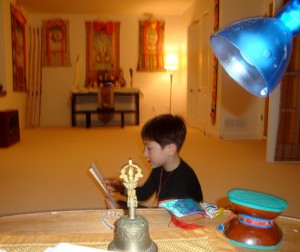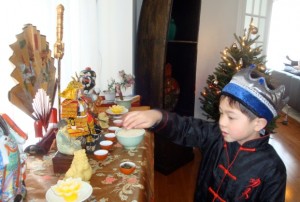Tuesday
Community ArticlesCreating a Cheerful Shambhala Household
By Neal Greenberg
As a Dorje Kusung, I had the great good fortune to work with the Druk Sakyong on many of the Shambhala forms and with the Sakong Mipham Rinpoche on creating a Shambhala Household. I live in a Shambhala household. Please permit me to share with you a few ideas in this regard.
Though I am weak in unbiased compassion, I do love my family greatly. I do my best to bring my family into the world of Shambhala principals as genuinely as I can. They do not all practice formally, though I feel they practice authentically. With my oldest children I didn’t do so well. Now I think I am more mature and can be more helpful to my younger ones. From today’s vantage point, I have a better vision of how to create a good home, one with humor and delight. I am raising my six-year-old son and two-year-old daughter in a Shambhala context, and I am encouraged by what I see.
Here are a few points. The Sakyong talked about cleaning the stove—the “hearth,” as the Druk Sakyong used to call it. I think this applies to the entire house, but particularly the kitchen and the shrine rooms. Dralas seem to like clean households. There is a psychological issue here. You are willing to relate with the entire situation beyond any sort of laziness. Cleaning creates wakefulness and cheerfulness, although it creates poignancy and sadness as well, as you relate more genuinely with the dark corners of your life. You decided where the tea or the incense would go when not in use, and you actually put it away. That effort creates harmony in the environment.
The next point is humor. Once when I was leaving the shrine tent with the Druk Sakyong during the 1985 seminary, people were bowing to him. Instead of the precise, elegant bow that he had intended in the Japanese model, everyone bowed in an obsequious, self-consciously religious fashion and with what seemed like a bit of a “hunch” back. Though I almost never saw the Druk Sakyong become upset or irritable, he growled as we were leaving, “They are so fucking religious.” I think he was suggesting that these bows lacked humor, precision and celebration. The bow was “all about me,” as Sakyong Mipham Rinpoche says.
In our house, we try to have a sense of celebration and delight in the environment. The children participate each night in the closing chants. My six-year-old has memorized a few of the protector chants because he found it fun to do. We do these chants almost without fail. He does a few prostrations, three warrior bows, an aspiration, and then a final warrior bow. He usually performs the final offering as well. His aspiration is quite simple, something like, “Please grant my family and my friends and Tashi (his sister), and Mommy and Carol (his godmother) happiness and long life.” His sister joins in with the prostration but likes to introduce a little chaos, attempting to upset the shrine in some way. Often, my wife (who is not a formal Buddhist practitioner) does a similar aspiration and several warrior bows along with Carol, who was raised as a Chinese Buddhist. My wife was convinced these practices work when Carol noted the presence of the lineage while practicing.
I think, for my son, it is important that he enjoys practicing. No heaviness or religiousness accompanies it. Practice bring him precision and joy. Once he was complaining his sister had wronged him. I invited him to come up and do his bows. I asked him to sit for a minute cross-legged. He cheered up and stopped complaining.
Lately in our household, we try to limit and even eliminate complaining, but because of me, we are not always successful. Complaint seems to inhibit a cheerful Shambhala culture. It brings everyone down, making the atmosphere heavy, less joyful, less potent. Windhorse seems to diminish. The Sakyong recently chided me when I started to complain about someone. I have never heard him complain about anyone ever. My wife, clearly a good “queen principle,” as the Sakyong described it in his talk on households, is always reminding me to stop complaining, and I am trying to listen to her. Her advice is earthy and honest. It comes from seeing how badly complaint affects others.
In a sentence, precision (cleanliness), humor, and absence of complaint seem to provide a good start for a Shambhala household. But do not forget love and honesty.
Neal Greenberg (Mipham Jampa) is a senior student of Sakyong Mipham Rinpoche, a senior teacher, Kusung Officer, and attaché for the Druk Sakyong, involved with the Sangha since 1973.








May 25, 2010
Reply
I think Shambhala principles (like basic goodness) would be extremely beneficial to a developing child. I kind of wish I was raised in such an environment.
I always cringe though when I see children involved in religion. I would hope no Shambhalian would ever force their children to accept something, or God forbid, do a practice they were not curious about. How many bad imprints of Christianity have been caused by forced Church attendance?
I think space for children to choose is essential.